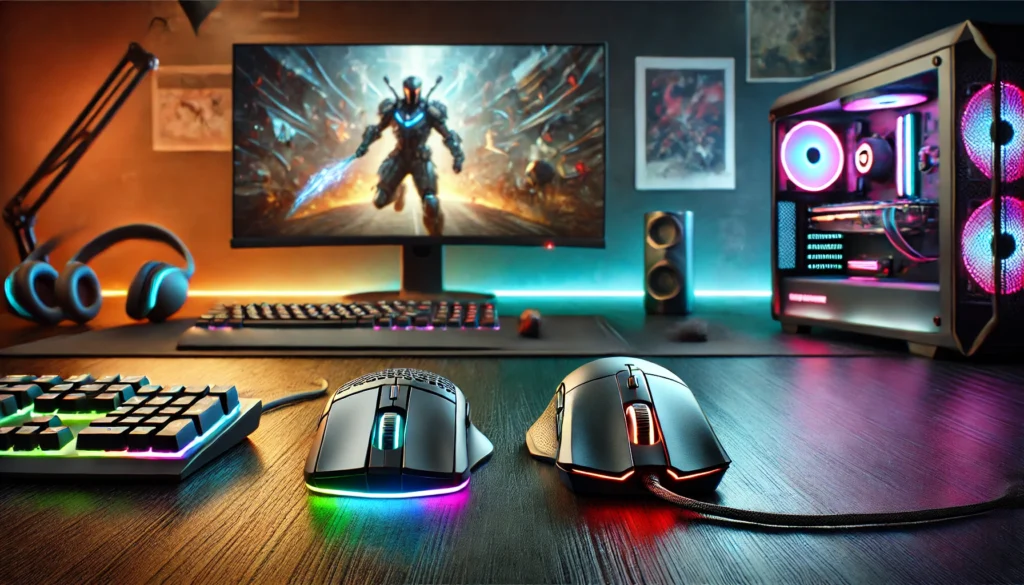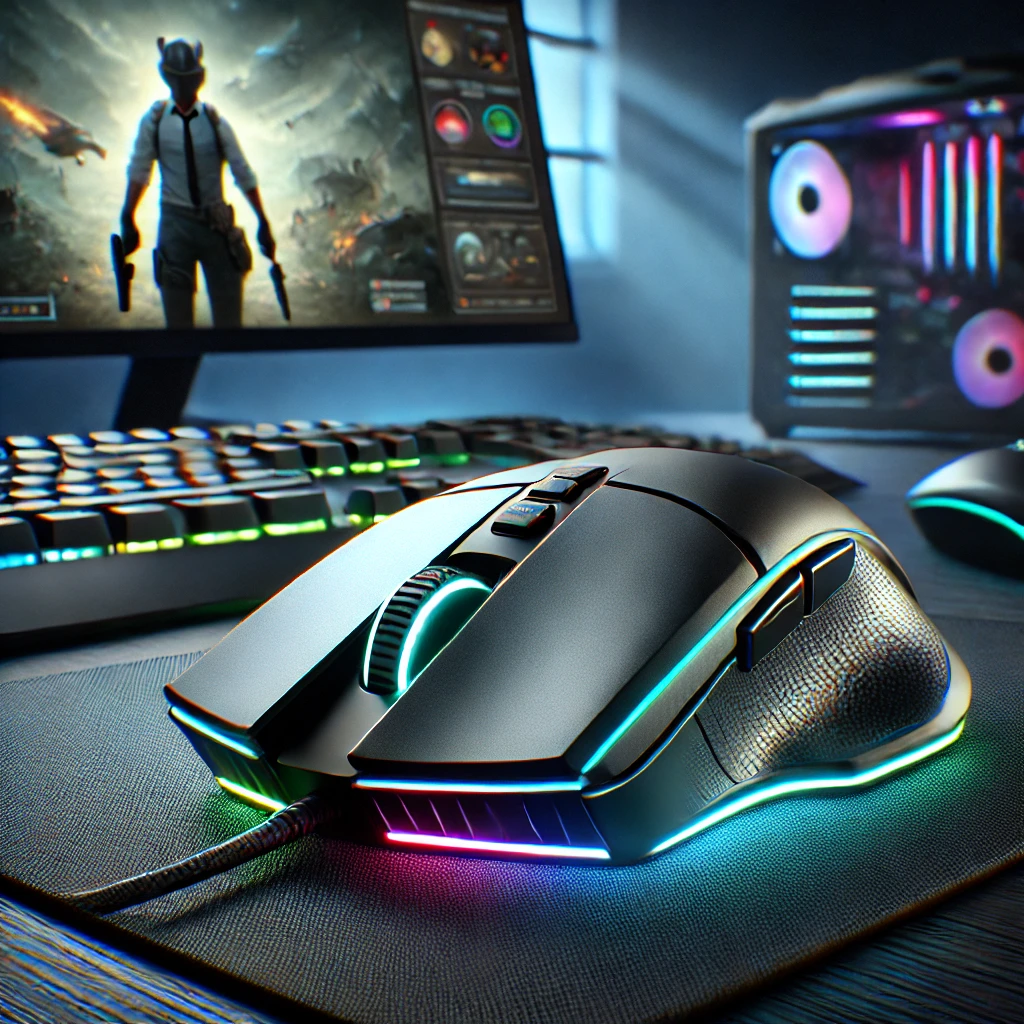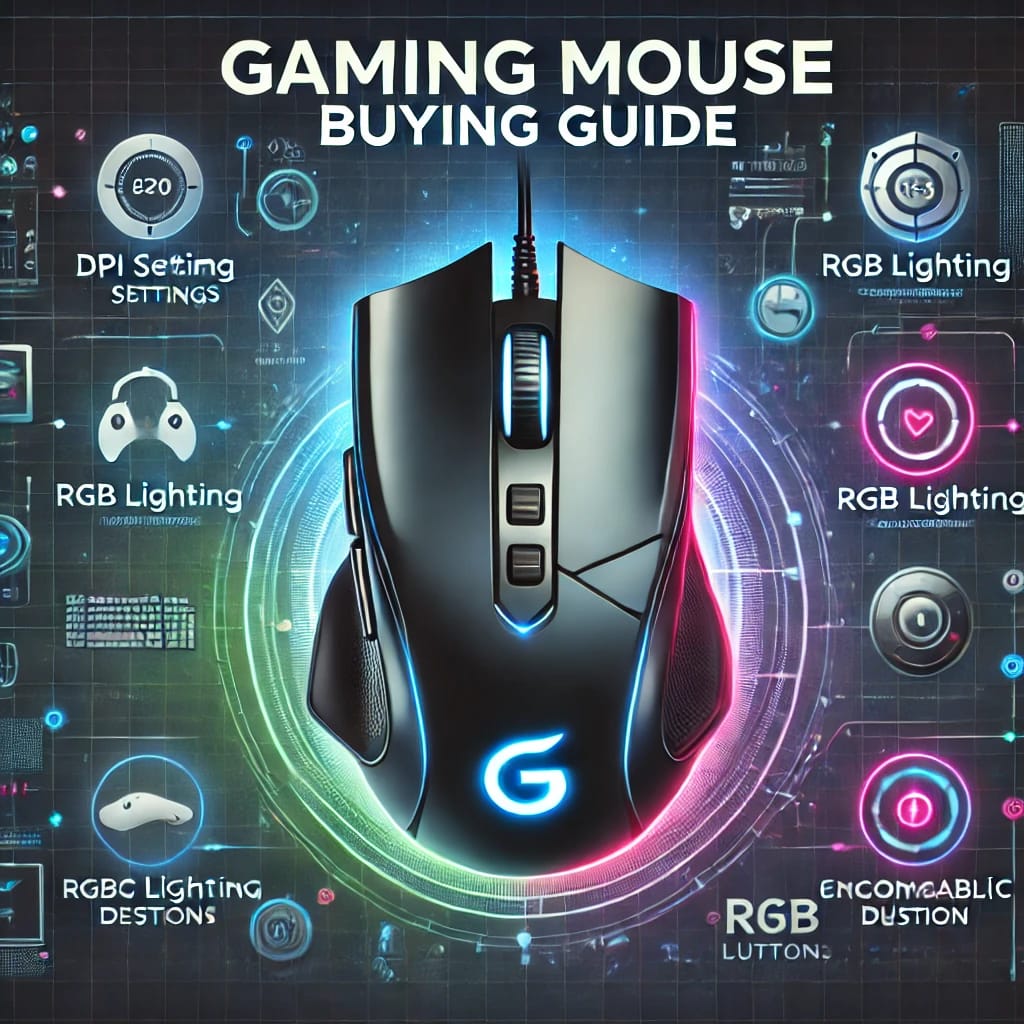When it comes to gaming, the tools you use can make all the difference between victory and defeat. Among these, the gaming mouse stands as one of the most critical components in a gamer’s arsenal. Its precision, speed, and comfort can greatly impact your gameplay experience, whether you’re aiming for headshots in an FPS or executing precise commands in a strategy game. Wireless vs Wired Gaming Mouse Which Is Better
But one question has divided gamers for years: Is a wireless gaming mouse better than a wired gaming mouse, or vice versa? Both options come with their own set of advantages and drawbacks, and the debate continues as technology evolves.
This article dives deep into the wireless vs. wired gaming mouse debate, examining key factors like performance, battery life, input lag, and overall convenience. Whether you’re a competitive gamer looking for reliability or a casual player seeking a hassle-free setup, this guide will help you understand the differences and make an informed decision.
By the end, you’ll know which type of gaming mouse suits your playstyle, budget, and preferences. So, let’s settle the score and find out which gaming mouse is the ultimate choice for your needs.

Why the Gaming Mouse Matters
When it comes to gaming, having the right tools can make all the difference. A gaming mouse isn’t just another accessory; it’s an extension of your gameplay. Unlike standard mice, gaming mice are designed to deliver precision, speed, and reliability that cater to the intense demands of modern gaming. Whether you’re aiming for headshots in an FPS game or managing multiple commands in an RTS, a high-performance mouse can be the key to victory.
One of the primary reasons gaming mice stand out is their superior DPI (dots per inch) settings. While a standard mouse typically offers limited DPI options, a gaming mouse allows you to adjust sensitivity levels to match your playstyle. This feature is especially crucial for gamers who require quick reflexes and pinpoint accuracy.
Responsiveness is another critical factor. Gaming mice are equipped with advanced sensors that minimize input lag, ensuring that every click and movement translates instantly on-screen. This level of responsiveness is particularly beneficial for competitive gamers, where even milliseconds can determine the outcome of a match.
Additionally, gaming mice often come with customizable features, such as programmable buttons and ergonomic designs. These elements not only enhance comfort during long gaming sessions but also provide functional advantages like quick access to macros or in-game shortcuts.
In contrast, standard mice are better suited for general tasks like browsing or office work. They lack the advanced technology and customization options that gamers rely on for optimal performance.
Choosing the right gaming mouse, whether wired or wireless, can significantly enhance your gaming experience. Its precision, responsiveness, and tailored features give you a competitive edge, making it an essential part of any gaming setup.
Overview of Wireless and Wired Gaming Mice
When choosing a gaming mouse, understanding the differences between wireless and wired options is essential. Each type has its own unique characteristics, making them suitable for different gaming preferences and setups.
Wireless Gaming Mice
Wireless gaming mice have revolutionized how gamers interact with their setups. Unlike traditional wired mice, wireless mice rely on technologies such as USB dongles or Bluetooth to establish a connection. This eliminates the need for cables, offering greater freedom of movement and a cleaner desk aesthetic.
The history of wireless gaming mice has seen significant improvements over the years. Early models were plagued by issues like input lag and limited battery life, making them less appealing to serious gamers. However, advancements in low-latency technology, such as Logitech’s Lightspeed and Razer’s Hyperspeed, have made modern wireless gaming mice as responsive as their wired counterparts.
Battery life is another area where wireless gaming mice have made strides. Many current models provide extended playtime, with some lasting over 70 hours on a single charge. Some even include quick charging options, ensuring minimal downtime. These advancements make wireless gaming mice an excellent choice for gamers seeking convenience without compromising performance.
Wired Gaming Mice
Wired gaming mice have long been a staple in the gaming world due to their reliability and performance. They connect directly to a computer via a cable, ensuring a stable connection with zero risk of interference or battery depletion.
The longevity of wired mice in gaming setups is a testament to their consistency. Gamers appreciate the absence of latency and the peace of mind that comes with uninterrupted gameplay. Additionally, wired gaming mice are often more affordable than their wireless counterparts, making them a practical option for budget-conscious gamers.
Both types of gaming mice cater to distinct preferences, but understanding their strengths can help you make an informed choice.

Key Factors to Consider
When choosing between a wireless gaming mouse and a wired gaming mouse, it’s essential to evaluate key factors such as performance, power, portability, durability, and aesthetics.
Performance and Latency
Performance is a top priority for gamers, and latency can make or break your experience. Wired gaming mice have long been praised for their stable, low-latency performance, making them a favorite for competitive gaming where every millisecond counts. On the other hand, advancements in wireless technology, such as Logitech’s Lightspeed and Razer’s Hyperspeed, have significantly reduced input lag in wireless gaming mice. Today, many wireless options rival their wired counterparts in terms of responsiveness.
Battery Life vs. Constant Power
Battery life is a critical consideration for wireless gaming mice. Some models offer extended battery life, with up to 70 hours of use, but frequent charging can interrupt your gaming sessions. Wired gaming mice, however, are powered continuously through their cables, eliminating the need for charging altogether and offering uninterrupted gameplay.
Portability and Convenience
Wireless gaming mice excel in portability. They’re easy to pack and ideal for gamers who travel or use laptops. Conversely, wired mice require cable management, which can be cumbersome, but they offer a hassle-free, plug-and-play solution that appeals to desktop gamers.
Durability and Maintenance
Wired gaming mice often have the edge in durability due to their simple design and lack of batteries. Wireless gaming mice, while convenient, are more prone to wear and tear, particularly in charging ports and battery components.
Aesthetics and Desk Setup
A wireless gaming mouse offers a sleek, cable-free setup that enhances desk aesthetics, especially for minimalist setups. Wired gaming mice, while less visually appealing, contribute a classic retro look and eliminate concerns about connectivity interruptions.
By weighing these factors, gamers can select the mouse type that best matches their needs and preferences.
Use Case Scenarios: Who Should Choose Which Type of Gaming Mouse?
Choosing between a wireless and wired gaming mouse often comes down to personal preferences and specific use cases. Here’s a breakdown to help you decide.
Who Should Choose a Wireless Gaming Mouse?
Wireless gaming mice are ideal for gamers who value freedom of movement and a clean desk setup. Casual gamers, in particular, may appreciate the convenience and portability that wireless options offer. If you frequently game on a laptop or travel with your setup, a wireless mouse eliminates the hassle of dealing with cables.
Additionally, gamers who prioritize aesthetics and mobility will find wireless gaming mice appealing. These mice often come with sleek, modern designs that enhance the overall look of a gaming setup. The absence of cables not only reduces clutter but also complements minimalist or high-tech gaming environments.
However, keep in mind that wireless gaming mice may require regular charging or battery replacement, depending on the model. If you don’t mind these minor inconveniences, a wireless mouse could be the perfect fit for your gaming needs.
Who Should Choose a Wired Gaming Mouse?
For competitive gamers, a wired gaming mouse is often the top choice due to its consistent, reliable performance. Wired mice eliminate the risk of input lag and battery-related interruptions, making them a favorite for esports players and enthusiasts who need split-second precision.
If you’re budget-conscious, wired gaming mice also tend to offer better performance at a lower price point compared to their wireless counterparts. They are a great option for gamers who want high-quality performance without overspending.
Additionally, wired gaming mice are a reliable choice for those who don’t want to worry about maintenance, such as replacing batteries or ensuring regular charging. For stability and cost-effectiveness, a wired gaming mouse is hard to beat.
Price and Value Comparison
When it comes to choosing between a wireless and wired gaming mouse, price plays a significant role in the decision-making process. Let’s break down the cost analysis of these two options.
Cost Analysis: Wireless vs. Wired Gaming Mice
Wired gaming mice are generally more affordable than their wireless counterparts. With a wired mouse, you’re mainly paying for the quality of the sensor, ergonomics, and features such as DPI adjustments and customizable buttons. A good-quality wired mouse can typically be found for anywhere between $30 and $80, depending on the brand and features.
On the other hand, wireless gaming mice tend to be priced higher due to the additional technology required to ensure low latency and seamless performance. High-end models with advanced wireless technology (such as Logitech’s Lightspeed or Razer’s Hyperspeed) can cost anywhere from $70 to $150 or more. These mice often incorporate cutting-edge sensors, long battery life, and customizable settings, making them a premium option for serious gamers.
Additional Expenses for Wireless Mice
While the initial purchase price is higher for wireless gaming mice, there are other ongoing expenses to consider. For instance, many wireless models require batteries or a charging dock. Depending on your usage, you may need to replace batteries every few months or frequently recharge your mouse. Some mice come with rechargeable batteries, but you might still need to purchase additional charging accessories, such as docks or USB-C cables, which can add up over time.
Affordability and Value for Different Budgets
If you’re on a tight budget, a wired gaming mouse offers great value without sacrificing performance. Many wired mice feature top-tier sensors and responsiveness, perfect for competitive gaming at a fraction of the cost of wireless options. However, if you prioritize convenience, mobility, and cutting-edge technology, investing in a wireless mouse could be worthwhile, as long as you’re prepared for the extra costs of charging and replacing batteries.
Ultimately, the best choice depends on your budget and how much you value performance versus convenience.
Popular Models: Wired and Wireless Gaming Mice
When choosing between a wired or wireless gaming mouse, it’s essential to consider the top models in each category to make an informed decision. Here are some popular choices for both types of mice, highlighting their pros and cons:
Wireless Gaming Mice
1. Logitech G Pro X Superlight
The Logitech G Pro X Superlight is one of the most popular wireless gaming mice due to its lightweight design and high-end performance. Equipped with Logitech’s Lightspeed wireless technology, it offers an ultra-low latency, making it an excellent choice for competitive gamers.
Pros:
Extremely light, weighing just 63 grams.
Lightspeed wireless technology for fast and reliable performance.
Hero sensor for precision up to 25,600 DPI.
Cons:
Expensive compared to other wireless mice.
No RGB lighting, which may be a downside for some gamers.
2. Razer Viper Ultimate
The Razer Viper Ultimate is a top contender for esports professionals, offering an ultra-responsive experience with Razer’s HyperSpeed wireless technology. It features a lightweight, ambidextrous design and a 20,000 DPI optical sensor for pinpoint accuracy.
Pros:
Ambidextrous design, suitable for both left and right-handed users.
Long battery life (up to 70 hours).
Razer Optical Mouse Switches for faster response.
Cons:
Higher price point than wired alternatives.
The lighter build might not suit all grip styles.
Wired Gaming Mice
1. SteelSeries Rival 600
The SteelSeries Rival 600 is known for its dual-sensor system, offering outstanding precision and reliability. With a high DPI of 12,000 and a unique split-trigger button design, it stands out as a highly responsive wired gaming mouse.
Pros:
Dual sensors for superior accuracy and tracking.
Customizable weights for personalized comfort.
High-speed tracking for fast-paced gaming.
Cons:
Heavier than some other gaming mice.
The cable can be stiff and cause drag during intense gameplay.
2. Razer DeathAdder V3
The Razer DeathAdder V3 is a trusted name in the gaming community, offering a solid wired connection with an updated 30,000 DPI optical sensor. Its ergonomic design makes it a comfortable choice for long gaming sessions.
Pros:
Highly ergonomic shape for comfort during extended use.
Upgraded sensor for exceptional precision.
Durable and built to last.
Cons:
Less portable due to the wired design.
The shape may not fit every hand size comfortably.
Each of these mice offers unique benefits tailored to different types of gamers. Whether you’re prioritizing lightweight design, performance, or precision, there’s a model that fits your needs.
Pros and Cons Summary
When deciding between a wireless gaming mouse and a wired gaming mouse, it’s essential to weigh the advantages and drawbacks of each. Both options offer unique benefits, but your gaming style and preferences will ultimately determine which is the best fit for you.
Wireless Gaming Mice
Pros:
One of the primary advantages of a wireless gaming mouse is the freedom from cables. Without the limitation of a cord, you can enjoy a cleaner, more organized desk setup, allowing for better mobility and less clutter. This added portability is especially beneficial for gamers who travel or play in various setups. The absence of a cable also contributes to a sleeker, more modern aesthetic, which many gamers prefer for their rigs. Additionally, with advanced wireless technologies like Logitech’s Lightspeed and Razer’s Hyperspeed, wireless gaming mice have virtually eliminated input lag, providing performance on par with wired models.
Cons:
On the downside, wireless gaming mice require charging, which can be a hassle, especially during long gaming sessions. Battery life varies across models, with some lasting for days and others only a few hours when heavily used. Another downside is that they tend to be more expensive than their wired counterparts, due to the advanced technology required for wireless functionality and power management.
Wired Gaming Mice
Pros:
Wired gaming mice are renowned for their reliability and consistent performance. With a wired connection, you never have to worry about latency, battery life, or interruptions due to a weak signal. These mice offer plug-and-play simplicity—just plug in the USB cable, and you’re ready to go. For competitive gamers, this steady connection ensures no disruptions, especially in fast-paced games where every millisecond counts.
Cons:
While wired gaming mice offer excellent performance, they come with the downside of cable drag. The wire can restrict movement, which may be an issue for gamers who value unrestricted freedom of motion. Additionally, the cord can create clutter on your desk, making it less portable and harder to keep your setup neat.
Future of Gaming Mice Technology
As gaming technology continues to evolve, so too does the design and functionality of gaming mice. One of the most exciting trends is the emergence of hybrid gaming mice—mice that offer both wired and wireless connectivity. These versatile mice give gamers the best of both worlds, allowing them to switch between the stability of a wired connection and the freedom of a wireless one. This hybrid flexibility addresses concerns about input lag in wireless models while offering the convenience of a cable-free setup when desired.
Another innovative development in wireless gaming mice is battery-free wireless charging. Companies like Logitech and Razer are leading the charge in this area with technologies that allow wireless mice to charge continuously while in use. With charging docks or charging pads integrated into gaming desks or mousepads, gamers no longer need to worry about running out of power during crucial moments. These charging solutions use inductive charging to keep the mouse powered without any direct connection, eliminating the need for frequent battery changes.
Looking ahead, we predict that the gap between wired and wireless gaming mice will continue to shrink. Manufacturers are working on improving wireless performance, including reducing latency and enhancing connection stability to match the reliability of wired options. Wireless mouse sensors are also becoming more advanced, delivering high precision and low latency, which was once only achievable with wired mice.
Additionally, the integration of RGB lighting and advanced software features in both wired and wireless gaming mice is expected to become even more seamless, offering gamers greater customization options. As technology advances, we’ll likely see even more cost-effective wireless gaming mice with enhanced performance, making them a more viable option for professional gamers and casual players alike.
In conclusion, the future of gaming mice is bright, with innovations that promise improved performance, convenience, and customization, making it an exciting time for gamers seeking the ultimate setup.

Conclusion
When deciding between a wireless and a wired gaming mouse, several factors should guide your choice: performance, convenience, budget, and personal preference.
Performance is crucial for serious gamers, and while wired gaming mice traditionally offer superior consistency with no input lag or battery concerns, advancements in wireless technology have closed the gap. Wireless mice like those with Lightspeed or Hyperspeed technology now provide nearly identical performance to their wired counterparts, making them a viable option for competitive gamers.
Convenience is where wireless gaming mice shine, offering freedom of movement without the hassle of cables. If you prioritize a sleek, clutter-free desk or enjoy gaming on the go, a wireless mouse might be the right choice. On the other hand, wired mice are more straightforward, requiring no charging and often offering plug-and-play functionality.
Budget is another key consideration. Wired mice tend to be more affordable, providing excellent value for gamers on a budget, while wireless mice, although pricier, offer added features like longer battery life and advanced wireless connectivity.
Ultimately, your decision should reflect your gaming style, preferences, and what you value most in a gaming mouse. Whether you opt for the reliability of a wired mouse or the flexibility of a wireless one, both have their place in today’s gaming world.
Faqs for Wireless vs Wired Gaming Mouse Which Is Better
1. Does a wireless gaming mouse have noticeable input lag?
No, modern wireless gaming mice are designed with advanced technology like Lightspeed and Hyperspeed to ensure negligible input lag, rivaling that of wired mice. However, performance may vary depending on the model and brand.
2. How long does the battery last on a wireless gaming mouse?
Battery life varies by model. Some wireless gaming mice offer up to 70+ hours of use on a single charge, while others may require frequent recharging. Mice with RGB lighting tend to have shorter battery life.
3. Are wired gaming mice still better for competitive gaming?
Wired gaming mice are often preferred by competitive gamers because they provide stable, lag-free performance without reliance on batteries or charging. However, many high-end wireless mice now offer similar reliability.
4. Can I use a wireless gaming mouse while charging?
Yes, many wireless gaming mice come with a detachable cable, allowing you to use them as a wired mouse while charging. This ensures uninterrupted gaming.
5. Which is more cost-effective: a wired or wireless gaming mouse?
Wired gaming mice are generally more affordable than wireless ones. Wireless mice often come with additional features like a charging dock or higher-end components, which can increase their price. The best choice depends on your budget and preferences.




